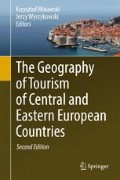Abstract
Tourism as a new discipline emerged in Hungary in the 1960s. Since then different topics have been researched, such as tourist conditions of the Balaton and Danube regions or medical tourism in Hungary. The 1980s was the time of the first comprehensive analysis of natural resources regarding tourism aspect. In the last decade of the twentieth century, some new topics were researched, such as city or rural tourism. The beginning of a new century meant a more interdisciplinary approach to tourism. This chapter presents the natural preconditions for tourism such as relief features, climatic, hydrologic and biographic conditions. Short description allows us to point the most attractive areas of the country in terms of recreation. The special attention is paid to the protected areas existing in Hungary, among them 10 national parks, whose potential concerning the tourist movement and the infrastructure supporting the reception of values is also discussed. The cultural part of tourist values is presented in the most important tourist sites—in this case: World Heritage Sites, culture centres and the most recognizable values represented by museums as a part of tangible heritage and cultural events as the intangible potential. The tourist infrastructure of the country is presented through both transport and sport-recreational and accommodation elements. First element along with the state of transport infrastructure describes hiking trails, cycling routes and winter sports facilities. The accommodation sector situation in the last two decades presents changes in its capacity and spatial differentiation. An important part is the analysis of the contemporary situation of tourist movement in Hungary: domestic and international tourism, seasonality and its regional distribution. In the last part, the main types of tourism such as spa and wellness or rural tourism are described.
Access this chapter
Tax calculation will be finalised at checkout
Purchases are for personal use only
Notes
- 1.
Information on one-day trips is stemming from sample-based survey of the Hungarian population. The survey is carried out for times a year by the Hungarian Statistical Office and involves a sample of 7500 persons (15.000 prior to 2008).
- 2.
This figure does not include the number air transit passengers, as they do not enter Hungary administratively.
References
Aubert, A. (2006). A turizmusföldrajz helye és súlya a nemzetközi és hazai geográfiai szakirodalom tükrében. In III. Magyar Földrajzi Konferencia tudományos közleményei. Budapest, 2006, szeptember 6–7 (pp. 1–8). Budapest: MTA Földrajztudományi Kutatóintézet. CD-kiadvány és http://geography.hu.
Aubert, A., & Szabó, G. (1992). A falusi turizmus újraindításának és fejlesztésének lehetőségei Baranya megye két eltérő adottságú településcsoportjában. Pécs: MTA RKK DTI.
Berényi, I. (1981). Az üdülőterületek felhasználásának kérdései Szentendre példáján (Területi kutatások 4) (pp. 109–118). Budapest.
Berényi, I. (1986). A települések természeti környezetének értékelése az idegenforgalom szempontjából (Idegenforgalmi közlemények 3) (pp. 3–9). Budapest.
Erdi, R., Zsembery, R., Gyalog, G. (2007). Facts & figures of protected sites in Hungary. Ministry of Environment and Water.
Formadi, K., & Mayer, P. (2010a). Employment as a factor of value creation in tourism. In A. Clarke (Ed.). Constructing Central Europe. Competitiveness in Tourism (pp. 299–313). Veszprém: Pannon Egyetem.
Formadi, K., & Mayer, P. (2010b). Strategic development of business event management. In J. Marak, J. Wyrzykowski (Eds.). Conditions of the foreign tourism development in Central and Eastern Europe, Vol. 11, Conditions, state and development perspectives of business tourism (pp. 25–35). Wrocław: University of Wroclaw.
Hungarian Central Statistical Office. (2016). www.ksh.hu.
Hungarian Convention Bureau. (2016). www.hcb.hu.
Hungarian Tourism Plc. (2016). www.itthon.hu.
Jancsik, A., Madarasz, E., Mayer, P., Raffai, Cs. (2009a). Does it everyone differently? – destination management approaches in Hungary. In J. Marak, J. Wyrzykowski (Eds.). Tourism Role in Regional Economy, Vol. II. Wroclav: Wyzsza Szkola Handlowa.
Jancsik, A., Madarasz, E., Mayer, P., Raffai, Cs. (2009b). Tourinform offices’ attitudes towards change and innovations. In Kultúrák találkozása a Turizmusban. Győr: Nyugat-Magyarországi Egyetem.
Kollarik, A. (1991). Területfejlesztés, környezetvédelem és az idegenforgalom. Budapest: BKE-AULA.
Kóródi, J., & Somogyi, S. (1968). Idegenforgalmi Földrajz I–II. Budapest: Közgazdasági és Jogi Könyvkiadó.
Mayer, P., & Priszinger, K. (2010). Tourism As Solution – Perceived Risks Influencing Participation in Health-Related Tourism. Journal of Tourism Challenges and Trends, 3(2), 141–151.
Michalkó, G. (1999). A városi turizmus elmélete és gyakorlata. Budapest: MTA FKI.
Michalkó, G. (2005). A humánökológia szerepe a magyarországi turizmusföldrajz modernizációjában. Turizmus Bulletin, 9(1), 32–42.
Pawlitz, A., & Mayer, P. (2010). Financing Tourist Information Service. Comparative Study of West Pomerania Province, Poland and Lake Balaton, Hungary. In Scientific Journal of Szczecin University, 592 (Economic Problems of Tourism 14). Szczecin: University of Szczecin.
Pécsi, M. (1967). III. Idegenforgalmi Kollokvium. 1966. Budapest Panoráma.
Porter, M. (1990). Competitive Advantage of Nations. New York: Free Press.
Puczkó, L., & Smith, M. (2008). Health and Wellness Tourism. Elsevier/ Butterworth-Heinemann.
Somogyi, S. (1981). Magyarország természeti adottságai az országos üdülőterületi terv szempontjából. Budapest: MTA FKI.
Somogyi, S. (1987). Magyarország természeti adottságainak idegenforgalmi szempontú értékelése. Elmélet, módszer, gyakorlat. Budapest: MTA FKI.
Author information
Authors and Affiliations
Corresponding author
Editor information
Editors and Affiliations
Rights and permissions
Copyright information
© 2017 Springer International Publishing AG
About this chapter
Cite this chapter
Formadi, K., Mayer, P., Pénzes, E. (2017). Geography of Tourism in Hungary. In: Widawski, K., Wyrzykowski, J. (eds) The Geography of Tourism of Central and Eastern European Countries. Springer, Cham. https://doi.org/10.1007/978-3-319-42205-3_6
Download citation
DOI: https://doi.org/10.1007/978-3-319-42205-3_6
Published:
Publisher Name: Springer, Cham
Print ISBN: 978-3-319-42203-9
Online ISBN: 978-3-319-42205-3
eBook Packages: Earth and Environmental ScienceEarth and Environmental Science (R0)

